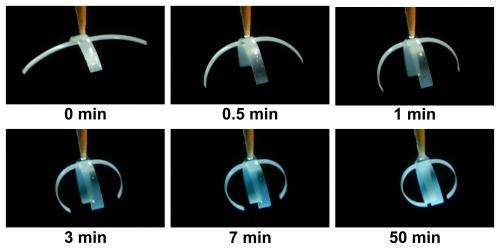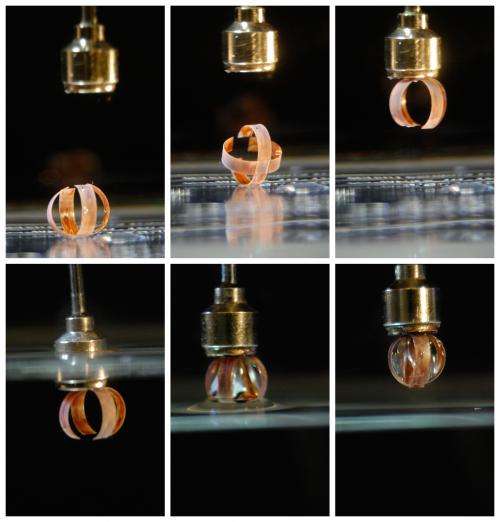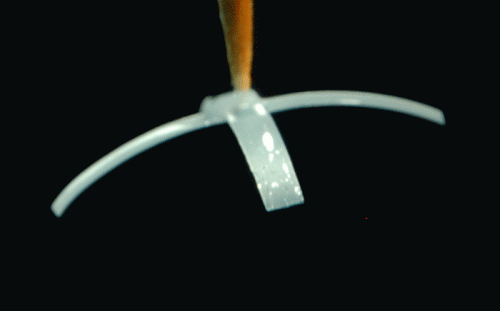Scotch tape finds new use as grasping 'smart material'

(Phys.org)—Scotch tape, a versatile household staple and a mainstay of holiday gift-wrapping, may have a new scientific application as a shape-changing "smart material."
Researchers used a laser to form slender half-centimeter-long fingers out of the tape. When exposed to water, the four wispy fingers morph into a tiny robotic claw that captures water droplets.
The innovation could be used to collect water samples for environmental testing, said Babak Ziaie, a Purdue University professor of electrical and computer engineering and biomedical engineering.
The Scotch tape - made from a cellulose-acetate sheet and an adhesive - is uniquely suited for the purpose.

"It can be micromachined into different shapes and works as an inexpensive smart material that interacts with its environment to perform specific functions," he said.
Doctoral student Manuel Ochoa came up with the idea. While using tape to collect pollen, he noticed that it curled when exposed to humidity. The cellulose-acetate absorbs water, but the adhesive film repels water.

"So, when one side absorbs water it expands, the other side stays the same, causing it to curl," Ziaie said.
A laser was used to machine the tape to a tenth of its original thickness, enhancing this curling action. The researchers coated the graspers with magnetic nanoparticles so that they could be collected with a magnet.
"Say you were sampling for certain bacteria in water," Ziaie said. "You could drop a bunch of these and then come the next day and collect them."
Findings will be detailed in a presentation during a meeting of the Materials Research Society in Boston from Sunday (Nov. 25) to Nov. 30. Experiments at Purdue's Birck Nanotechnology Center were conducted by Ochoa, doctoral student Girish Chitnis and Ziaie.
The grippers close underwater within minutes and can sample one-tenth of a milliliter of liquid.
More information: Laser-Micromachined Magnetically-Functionalized Hygroscopic Bilayer: A Low-Cost Smart Material,
Abstract
In this paper, we describe the design, fabrication, and characterization of magnetically functionalized humidity-responsive bilayers. We investigated two different ferrofluid embedded material structures: 1) cellulose-acetate sheet bonded to an acetate-backed adhesive (3M Scotch® GiftWrap Tape) (CA/GWT) and 2) a commercially available acetate-backed adhesive (3M Scotch® MagicTape) (MT). Cantilevers and other mechanical structures such as grippers were fabricated using laser micro-machining and exposed to humidity and magnetic fields. Such bilayers take advantage of the hygroscopic properties of cellulose acetate for their humidity response while simultaneously allowing one to remotely manipulate the structure using a magnetic field. The maximum radius of curvature in a humidity saturated environment for a CA/GWT cantilever (2 mm × 19 mm × 157 µm) was measured to be 7 mm, whereas the MT showed a smaller radius of curvature (< 3 mm). It was found that the humidity response of the MT cantilevers to be a function of the angle between the longitudinal axis of the cantilever and polymer orientation. For cantilevers cut at an angle 80 degree with respect to dominant polymer orientation a tip rotations of up to 25 degrees was measured. The magnetically-functionalized MT cantilevers were used as building blocks to create four-finger grippers that close underwater within minutes, can sample 100 µL of liquid, and can be remotely collected with a small permanent magnet.
Provided by Purdue University




















